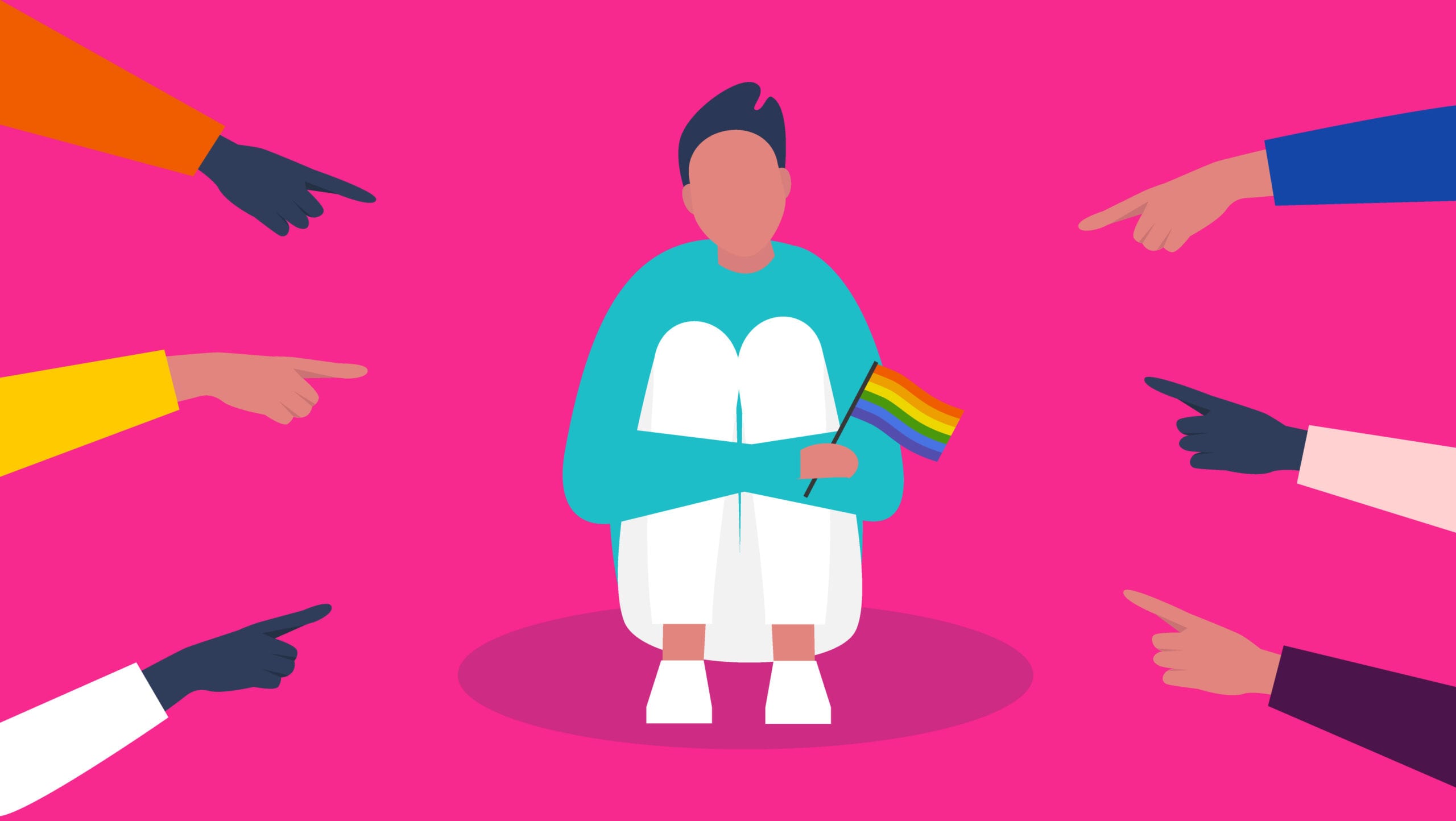Every year on April 8, school staff and students across the globe recognize the International Day of Pink. Along with Pink Shirt Day in February, it’s one of a number of events that schools participate in to raise awareness about bullying, including homophobic and transphobic mistreatment. (This year, with Canadian schools shuttered to reduce the spread of COVID-19, I imagine most anti-bullying days will be conducted on social media and through online instruction.)
As an elementary school teacher in Toronto, I’ve helped student Gay-Straight Alliance (GSA) members organize many of these events over the years. And as a queer man who was bullied for being different nearly 50 years ago in middle school, I’m gratified to see an era in which this behaviour—while still very much a problem—is not being treated like a rite of passage.
Discourse about bullying in my time and place lacked nuance: Every family sitcom I ever watched as a kid did a requisite episode on it. The targets and perpetrators were invariably male; the bullying was always physical, with a bigger, brutish boy being the aggressor (think Nelson Muntz from The Simpsons). In these narratives, it fell to the bullied kid’s father to dispense wisdom while taking his son out to the garage, where two pairs of boxing gloves awaited them in a cardboard box. It was done and dusted in 30 minutes.
But in the last decade or so, there’s been a dramatic shift in how we look at bullying and harassment among youth. The youngest of school children can now articulate many forms of bullying besides physical abuse, including cyberbullying (which is very much a concern right now with hundreds of thousands of youngsters living in physical isolation), coercion or social alienation. School curricula teach them that kids get bullied because of body type, race, personal beliefs, gender expression and so on. In LGBTQ2 communities, we readily summon the names of children we’ve never met who could not bear that suffering anymore.
Those more thoughtful conversations about bullying have in turn sparked action among students. In 2007, Nova Scotia high-schoolers David Shepherd and Travis Price learned of a ninth grade boy who was harassed and threatened for wearing a pink shirt to school. They bought pink shirts for other boys to wear as a sign of solidarity. Their work grew into Pink Shirt Day, which helps fund anti-bullying initiatives and raises awareness of the impact of bullying. The same year, Jeremy Dias, former executive director of the Canadian Centre for Gender and Sexual Diversity, launched International Day of Pink, with an added focus on homophobia and transphobia. Both groups provide resources to schools and other organizations to mount a pink day event.
What I find appealing about the pink day model is that it centres young people as problem solvers, and it turns bystanders into allies. During these campaigns, social media platforms enable students, families and educators to see the creativity and passion of young people. Pink days can be a launching pad for rich discussion about our inherent uniqueness as human individuals. At the ground level, a lot of good can come from them if we’re persistent in reinforcing the work throughout the year.
But these anti-bullying campaigns have their limits. We cannot expect to serve queer, questioning, trans and non-binary kids and others who experience mistreatment in a single day.
Most health professionals and educators agree that there are three key components to bullying: First, the behaviour is persistent over time. These are not one-off events—people are targeted. There is a real or perceived power imbalance, which might include age, physical size, popularity, economic advantage or even the number of aggressors. Finally—and this is very important—there is an intent to do harm. In the most dire cases, a high level of intervention is required.
“We cannot expect to serve queer, questioning, trans and non-binary kids and others who experience mistreatment in a single day”
It’s absolutely marvellous—and I would say essential—that students rallied around the victim in the Nova Scotia case. But that level of abuse can’t be remedied with just a pink shirt, and our governments are beginning to recognize that: In the aftermath of the suicide of Rehtaeh Parsons, Nova Scotia enacted legislation regarding bullying and cyber-bullying, and Ontario similarly amended its Education Act to include specific provisions on bullying. It befalls educators, administrators and parents to make sure this legislation is taught and enforced every day of the year.
In the day-to-day, however, teachers, parents and children see a lot of behaviours that don’t rise to the threshold of bullying but still need to be addressed. As I began writing this essay in March, for instance, a Grade 1 teacher asked me if we had a copy of Patricia Polacco’s picture book In Our Mothers’ House in our library. He was responding to an incident in which a child casually remarked, “Two women getting married is icky.” It was a thoughtless comment, but the potential for harm existed. The teacher seized on an opportunity to remind young children that all of their families have a place in our school. The answer was to validate those hurt and to give the child who said it the opportunity to reflect—in other words, a teachable moment.
Harm also occurs invisibly, without any action or intent. Many years ago, I knew a student in our GSA who was early in their gender transition and had changed schools in order to begin this journey. Their parents were lovely and offered good support to their child. Staff were thoughtful about meeting the student’s needs. But in this process we began to reflect upon how gendered the school day was—right down to late slips printed at the front desk with a letter M or F, originating from the student database. With this child in mind, our group looked at other names for our “Gay-Straight Alliance” that would include gender diversity, as well as sexuality. We settled on “Rainbow Alliance.”
And then there’s name-calling. Three years ago, several primary kids came running up to me at recess complaining that they had heard others “making fun of gay people.” In a moment of silliness, some Grade 3 students were telling each other they “looked like gay ladies,” and then it got loud and heated. Noting their names, I said I’d be in touch later for a chat. The goal was to have an open discussion about everything that was said, not just who said it first. We talked about what the word “gay” meant, we talked about past Day of Pink and Pride events at school and we thought about who might have been hurt by these remarks. A couple of kids mentioned friends and family members who would be disappointed by their remarks. The urge to issue consequences or discipline sometimes distracts children from thinking about the choices they make.
“If we start early, there’s so much good, preventative work we can do to help set children up for happier lives. But it takes time and persistence”
If we start early, there’s so much good, preventative work we can do to help set children up for happier lives. But it takes time and persistence, and sometimes our efforts can be hampered. Just last year, on the International Day of Pink, former Ontario education minister Lisa Thompson flatly refused to acknowledge transphobia or homophobia in the Legislative Assembly, claiming that “those words don’t exist in my vocabulary.”
There can also be pushback from parents. In 2014, as my school’s GSA was making plans for International Day of Pink, I received an email from a parent who took exception to GSA members visiting her child’s Grade 1 classroom to talk about school plans for the event. She went on to say that Day of Pink was not truly an anti-bullying day but rather one that promoted LGBTQ2 issues, and that a GSA was inappropriate for a K-8 school. She closed her note by saying that her son and many other children would be absent from school that day.
Though our plans for the event fell well within school board policy and the Education Act, and guardians and parents had received advance notice, I let the matter drop. I was far more concerned about my students getting word of what she had said, knowing that they might be deeply hurt. Eventually, the school’s parent council officially supported the event and it went off without a hitch. Only four students were absent from those two rooms, including two children who had already been sick with the flu that week. The episode is a reminder to me that creating school environments that are safe and inclusive is a daily practice, not just an event in February or April.
Despite it all, I’ll still enjoy International Day of Pink with my students this year. Through e-learning and social media, we’ll figure out a way to disseminate readings and discussions with students. We’ll talk about all the ways we can support each other, particularly in an online environment. I have no doubt that many families will tweet selfies in pink, as they often do. I’ll also be wearing a very special shirt that was given to me by a colleague from our provincial teachers’ federation. It reads: “Wearing pink shirts doesn’t stop bullying. I do.”


 Why you can trust Xtra
Why you can trust Xtra


